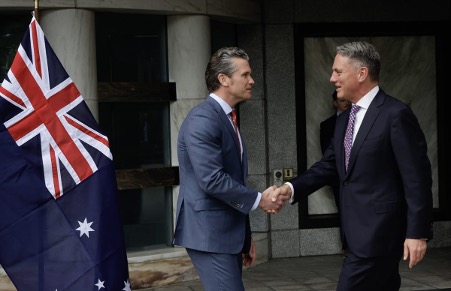
By Sam Roggeveen*
There is near universal agreement that Australia should spend more money on defence. The big political parties want to spend more. The defence commentariat overwhelmingly agrees. From The Interpreter. The Lowy Institute.
And last week, the United States made its views plain, with Defence Secretary Pete Hegseth curtly telling Australian Deputy Prime Minister and Defence Minister Richard Marles that “Australia should increase its defence spending to 3.5 per cent of its GDP as soon as possible.”
Don’t get too hung up on the figures – measuring defence spending as a percentage of GDP is a ropey business. But for the record, the government has pledged to raise defence spending to 2.4 per cent, and at the last election, the Liberal Party said it would go to 3 per cent within a decade. Given that current spending is just over 2 per cent of GDP, moving up to 3.5 per cent is a major lift that would require the government to either borrow more, cut spending, increase taxation, or all three. Neither side of politics has the political will for that.
Still, even if it’s not Hegseth’s preferred figure, there are several reasons why you might argue for higher defence spending in Australia. Let’s examine a few.
It is argued that Australia needs to spend more to keep the United States happy – Shadow Defence Minister Angus Taylor, for instance, says Australia needs to “carry our weight”. The US is constantly poking and prodding its allies to take on more of the burden, and although Australia has historically been exempted from such harangues, the prickly tenor of Hegseth’s remarks suggests those days are over.
But don’t forget, that’s Hegseth talking, not his boss. The Defence Secretary clearly belongs in the “prioritiser” school of Trump advisers, those who want to reduce the US military footprint in Europe and the Middle East to focus on China. But Trump shows no evidence of wanting to confront China militarily. As Hugh White says in his new Quarterly Essay, “Republican China hawks imagine that Trump has deserted Ukraine, abandoned Europe and courted Putin so that he can focus on defeating China to defend US regional and global leadership. But Trump has never believed that any of that really matters for America.”
Trump has a much narrower conception of America’s defence interests. Sure, he wants the US to be globally feared, but he has a hemispheric focus: Canada, Greenland, Panama, Mexico and the continental United States with the “Golden Dome” missile defence system are his pre-occupations. To paraphrase Trump, Australia isn’t terribly relevant because it is separated from the United States by a big, beautiful ocean. The only way Australia can help America is if you assume that the US has vital security interests in Asia. But since Trump does not believe this, why should Australia?
An alternative case for higher defence spending is that Australia needs to spend more precisely because the US is less reliable. That’s a more respectable argument. But it does raise uncomfortable questions about AUKUS, the plan to build eight nuclear-powered submarines for Australia’s navy, since those submarines really only make senseif Australia sees itself as an adjunct to a US-led military force. If Australia is going to revert to self-reliance, cancelling that submarine order would be a good start, because it would instantly free up a huge chunk of the defence budget. So would abandoning the planned big new warships for the navy, which are hopelessly vulnerable under modern combat conditions, as Russia has discovered in the Black Sea.
China’s military is formidable, but that’s no reason to abandon judgments about Australia’s defence that have stood the test of time.
Finally, we should talk about a surprisingly neglected topic: the threat. The only real reason to raise defence spending is if you think the danger of military attack has gone up. Has it?
Governments led by both major parties have produced policy papers which go some way to describing an increased threat from China. But governments tend to be coy about details, since there would be diplomatic repercussions if Australia was too explicit about its fears.
Defence commentators don’t have that excuse, yet to my knowledge, no major piece of research has been produced which details the military threat China poses to Australia. In late 2023, I published a book which devotes a chapter to examining the specifics of how China could attack Australia. I’m involved in a project which updates those findings, to be published later this year. I’m not aware of anyone else doing similar work. Given the clamour for higher defence spending, this is a strange state of affairs.
China’s military is formidable, but that’s no reason to abandon judgments about Australia’s defence that have stood the test of time. Defence planners have long recognised that the only way to project serious amounts of military force against Australia is to cross the vast sea-air gap to the north. Australia’s mission should be to defend that sea-air gap by maintaining forces which can shoot down planes and missiles, and sink ships and submarines, that encroach upon it.
That’s a difficult but achievable task for Australia. We don’t need to spend more to do it, but we do need to spend our defence dollars differently.
*Sam Roggeveen is Director of the Lowy Institute’s International Security Program. He is the author of The Echidna Strategy: Australia’s Search for Power and Peace, published by La Trobe University Press in 2023.



